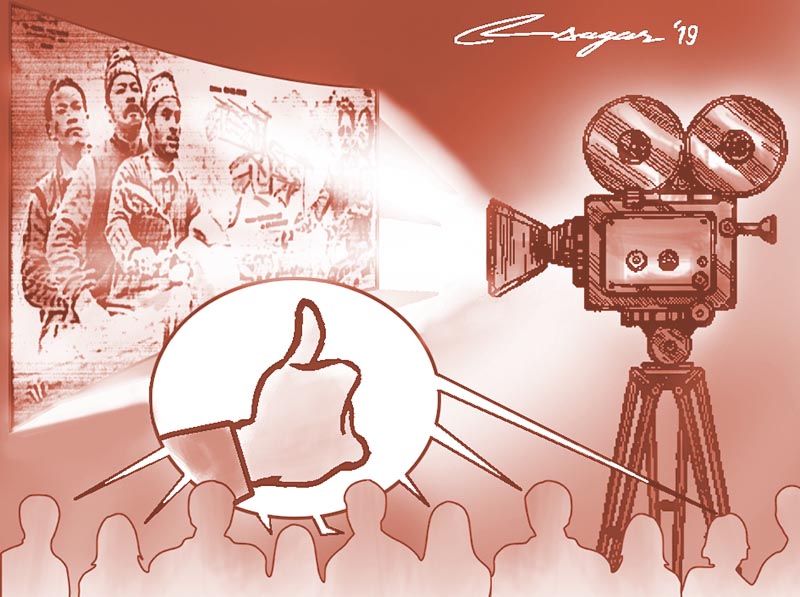Nepali cinema: A tale of two timelines
By the time Nepal produced its first film within national territory, Bollywood had already been in operation for half a century, and Alfred Hitchcock himself had directed more than 40 movies. These industries had already gone through a series of hits and trials and were competent in the fundamental aspects of filmmaking
Not often does one choose a Nepali movie over the likes of those produced by, let’s be honest, any international production company. Bollywood, for instance, has not only been our childhood companion, but also our foreign language instructor for quite some time. But in this visceral journey of mine from Bollywood to Hollywood, only recently have I been introduced to Nepalese characters.
Sometimes I feel that the Nepalese film industry gets unfairly chastised for being unable to meet the standards set by other industries. But maybe considering the political stability, or lack thereof, and the historical progress of Nepalese films, one has to wonder if the expectations drawn from foreign timelines truly make for an unbiased analysis of the state of domestic films.
By the time Nepal produced its first film within national territory, Bollywood had already been in operation for half a century, and Alfred Hitchcock himself had directed more than 40 movies. These industries had already gone through a series of hits and trials and were at a point in their timelines where they were competent in the fundamental aspects of filmmaking, thereby able to produce superior content. The Nepalese industry, on the other hand, was barely getting started. Satya Harischandra, which holds the title of being the first Nepali movie, was actually produced in Kolkata in 1951, and it wasn’t until 1966 that a movie was made under a private banner.
When you compare the style of most contemporary Nepali movies, mainly the cinematography, with the prevalent culture of early Hollywood compositions, one can find a lot of similarity. Tom Gunning characterised the early period of American cinema as being the ‘Cinema of Attractions’.
The emphasis was more towards highlighting the images and characters than it was towards the narrative progression of the story. As opposed to the voyeuristic aspect of narrative filmmaking, which is the current norm, early Hollywood movies tended to be exhibitionist in nature - something that most contemporary Nepali movies are guilty of being. Everything under the scope of the lens was made explicit. Gunning marks the year 1906 as the departure towards narrative filmmaking, the point after which the cinema of attraction was used merely as a tool to help convey the emotions evoked by the direction of the script.
Conventions, like the three-point lighting, are still an integral part of filmmaking, but creators have long understood that a single formula can’t serve for a variety of genres. For instance, musicals tend to rely on exhibition, whereas crime-thrillers and suspense movies require a sense of obscurity in the shots to go along with the dark nature of the characters.
If you discount movies like Hari, Kathaa or Kaagbeni, Nepali films, in general, tend to have a uniform exposure in their shots - everything is bright irrespective of the time of the day, let alone the mood of the characters. As was the case in the early period of Hollywood, the characters take the central stage, and the onus falls on them entirely to carry the story through their performance. And if they fail, so does the film.
As the current situation stands, most people go to the cinemas to see the actor, and not the story that he or she is part of. The inability of the script to lure the audience without a star character, for instance, as done by the Bollywood title Udaan, is perhaps the biggest challenge that the industry needs to overcome. At an age where there’s the Avengers, Bahubalis and other big budget wonders offered by foreign industries, the gap between us and them only seems to grow bigger by the year. But had we been a monolingual community, unable to comprehend both Hindi and English, and if we’d analysed our domestic film progress in independence, we perhaps would’ve been better able to appreciate the incremental progress in the Nepalese filmmaking timeline.
Where we are, fifty something years after the inception of the Nepali movie industry, is not half as bad as many people make it out to be. And let’s not forget, a decade of that was explicitly spent fighting for democracy.
Over the last few years we have seen significant progress in the commercialisation potential of Nepali movies. Along with that, individuals like Nischal Basnet, Ram Babu Gurung, Prashant Rasaily, Milan Chams, Hem Raj BC and the likes have started synthesising the cinema of attraction with narrative storytelling.
Nepal is a diverse community, and that in itself poses a great challenge for filmmakers. How does one create a storyline with characters that resonate with the entirety of the nation? In the next few years, as was the case in foreign industries, radical cinematography and soundtrack synchronisation are going to take pivotal stage in helping the characters move the story forward.
We need to take lessons from foreign timelines and make adjustments with ours if we want to bridge the gap. Ideas, not conventions, drive the movie industry, and it only takes a few good minds to come up with a fresh one.






